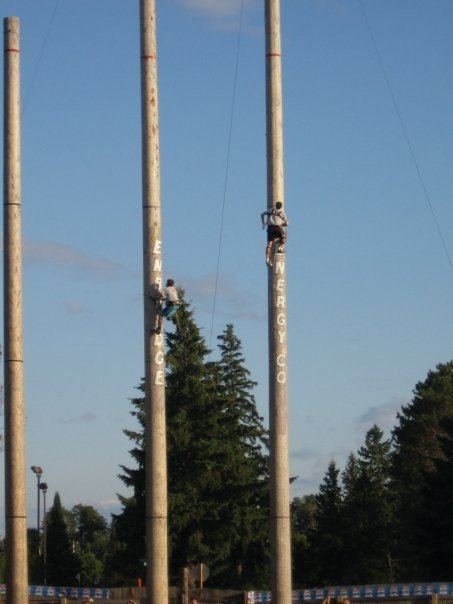 | ||
Speed climbing is climbing in which speed is the ultimate goal. Speed Climbing is done on rocks, walls and poles. In pure speed climbing, time is everything but it is also common to record speed ascents while observing a particular climbing style or ethic. For example, there are many speed records in which the climb was done according to free climbing ethics. In popular culture speed climbing may be best known for a viral video featuring Dan Osman climbing Lover's Leap via the Bear's Reach route (5.7, 400+ feet) in 4 min 25 sec. This clip was originally featured in the movie Masters of Stone IV.
Contents
Competition speed climbing
Competition speed climbing as governed by the International Federation of Sport Climbing takes place on 10m or 15m artificial walls. Competitors climb a slightly overhanging IFSC certified wall, with belaying from the top. Since 2007 the IFSC has created a standard wall for the world record. The holds and order are always identical, and the difficulty rating is around F6b, which is a level most recreational climbers could complete.
The climbing time is determined by mechanical-electric timing (the competitor strikes a switch at the top of the route) but manual timing is also possible. When mechanical-electric timing is used, the climbing time shall be measured with an accuracy of 0.01 second. As of 12.09.2014, Ukrainian climber Danyl Boldyrev holds the men's 15 meter speed world record; 5.60 seconds. Iuliia Kaplina from Russia holds the women's 15-meter speed record at 7.53 seconds.
Speed climbing World Champions 2016 are Marcin Dzieński from Poland (5.83 seconds) and Anna Tsyganova from Russia (7.52 seconds). IFSC Climbing World Championships took place in Paris, France.
Pure speed climbing
Full speed climbing is done in such a way that maximizes speed and minimizes danger. When climbing with a partner the climbers will alternate between regular free climbing, simul climbing, aiding, and at times sections of roped soloing. Speed climbing can also be done by an individual in which they alternate between forms of rope soloing, aiding, and free soloing. Strictly speaking this type of speed climbing is not a style but a combination or perhaps a type of aid climbing. However the complexity of combining all the styles together leads to what can be recognized as a separate style with its own particular techniques used in no other style.
Style climbing
Records can be recorded while climbing in a particular style. Each of the methods ultimately handicap the rate of progress with the exception of free soloing.
Free soloing
The simplest way to increase the speed of climbing is to shed all safety precautions such as belaying and placing protection. This leads to free soloing as rapidly as possible. While strictly speaking this qualifies as full speed climbing or a type of style climbing it is different enough to be recognized as its own category of speed climbing.
Records
Most speed climbing records lack the standards normally associated with objective records. Hans Florine has written "I will be the first to say that climbing is silly. To make rules about it is just piling ridiculous on top of silly." There are no sanctioned speed climbing competitions on significant rock features. Nearly all climbing goals and records are self-designed, self-timed, and self-officiated; few are well documented, and many are disputed.
The collection that follows abides by these loose standards.
Time formate either hrs:min or hrs:min:sec.
California
The Nose, El Capitan
Regular Northwest Route, Half Dome
Snake Dike, Half Dome
Joshua Tree National Park
Jackson Falls, Illinois
Colorado
Bastille Crack
Third Flatiron
Nevada
Epinephrine
Cat In The Hat
New York
The Gunks
Wyoming
Grand Traverse
